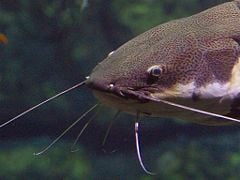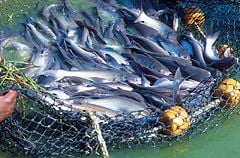Catfish
| Catfish | ||||||||
|---|---|---|---|---|---|---|---|---|
 | ||||||||
| Scientific classification | ||||||||
| ||||||||
|
Akysidae |
Catfish (order Siluriformes) are a diverse group of fish. Named for their prominent "barbels", which give the image of cat-like whiskers, they are found in freshwater environments of all kinds, with species on every continent except Antarctica. Some species from the families Ariidae and Plotosidae are also found in marine environments. They feature some of the smallest known vertebrates, including the candiru, the only vertebrate parasite to attack humans, as well as Pangasius gigas, the largest reported freshwater fish. There are armour plated types and also naked types, but they do not have scales. Not all catfish families have barbels; what defines a fish as being in the Siluriformes order are certain features of the skull and swimbladder.
Catfish belong to a superorder called the Ostariophysi, which also includes the Cypriniformes, Characiformes, and Gymnotiformes (although some place Gymnotiformes as a sub-order of Siluriformes). As of 2005 there are 37 catfish families, and around 2000 species have been described, although this number is in constant flux due to taxonomic work on the order.
In June, 2005, researchers named the 37th family of catfish, Lacantuniidae, only the third new family of fish distinguished in the last 70 years (others being the coelacanth in 1938 and the megamouth shark in 1983). The new species in Lacantuniidae, Lacantunia enigmatica, was found in the Lacantun river in Chiapas, Mexico.
Catfish have no scales. All catfish, except members of Malapteruridae (electric catfish), possess a strong, hollow, bonified leading ray on their dorsal and pectoral fins, through which a stinging protein can be delivered if the fish is irritated. In members of the family Plotosidae, and of the genus Heteropneustes, this protein is so strong it may hospitalize humans unfortunate enough to receive a sting.
Catfish range in size and behavior from the heaviest, the Giant Mekong Catfish (Pangasius gigas) in Southeast Asia and the longest Wels Catfish of Eurasia, to detritivores (species that eat dead material on the bottom), and even to a tiny parasitic species commonly called the candiru (Vandellia cirrhosa).
The wels catfish (Silurus glanis) is the only native catfish species in Europe, besides the much smaller related Aristotle catfish found in Greece. Mythology and literature record wels catfish of astounding proportions yet to be scientifically proved. The average size of the species is about 1,2m-1,6m, and fish more than 2m are very rare. The largest specimens on record measure more than 2.5m in length and sometimes exeeded 100kg. The wels catfish was introduced to Britain, Italy, Spain, Greece and some other countries during the last century. The species has flourished in the warm lakes and rivers of Southern Europe. The River Po in Italy and the River Ebro in Spain are famous for huge wels catfish, which grow up to 2m. These habitats contain plenty of food and lack natural predators.
Catfish, which have a sweet, mild flesh, are important as food fish throughout the world. However, the French, German, and Spanish cuisines do not hold the fish in high regard, and is mostly for tourist consumption.Ictalurids are cultivated in North America (especially in the Deep South with Mississippi being the largest domestic Catfish producer)[1], and representatives of the genus Ictalurus have been misguidedly introduced into European waters in the hope of obtaining a sporting and a food resource, however, the European stock of American catfishes have not achieved the dimensions of these fishes in their native waters, and have only increased the ecological pressure on native European fauna, while Clariids and Pangasiids are heavily cultured in Africa and Asia. There is also a large and growing ornamental fish trade, with hundreds of species of catfish, especially the genus Corydoras, being a popular component of many aquaria.
A very large wels catfish (Silurus glanis) was caught by Kevin Maddocks on August 6, 1999, recorded at 202 pounds (91.62 kilograms). Tim Pruitt of Illinois caught the largest blue catfish (Ictalurus furcatus) in the Mississippi River on May 22, 2005 that weighed in at 124 pounds (56.25 kilograms). The largest flathead catfish (Pylodictis olivaris) ever caught was in Independence, Kansas, weighed at 123 pounds 9 ounces (56 kilograms). However, these records pale in comparison to a Giant Mekong Catfish caught in northern Thailand in May 1, 2005 and reported to the press almost 2 months later, that weighed 646 pounds (293 kilograms). This is the largest Giant Mekong Catfish caught, but only since Thai officials started keeping records in 1981 [1]. The Giant Mekong Catfish are not well studied since they live in developing countries and it is quite possible that they can grow even bigger.
In the United States, June 25 is National Catfish Day.
Other catfish species include:
- Iridescent Shark
- Channel catfish
- Redtail catfish
ReferencesISBN links support NWE through referral fees
- ↑ J.E. Morris (October 1993). "Pond Culture of Channel Catfish in the North Central Region". North Central Regional Aquaculture Center. Retrieved 2006-06-28.
Credits
New World Encyclopedia writers and editors rewrote and completed the Wikipedia article in accordance with New World Encyclopedia standards. This article abides by terms of the Creative Commons CC-by-sa 3.0 License (CC-by-sa), which may be used and disseminated with proper attribution. Credit is due under the terms of this license that can reference both the New World Encyclopedia contributors and the selfless volunteer contributors of the Wikimedia Foundation. To cite this article click here for a list of acceptable citing formats.The history of earlier contributions by wikipedians is accessible to researchers here:
The history of this article since it was imported to New World Encyclopedia:
Note: Some restrictions may apply to use of individual images which are separately licensed.

